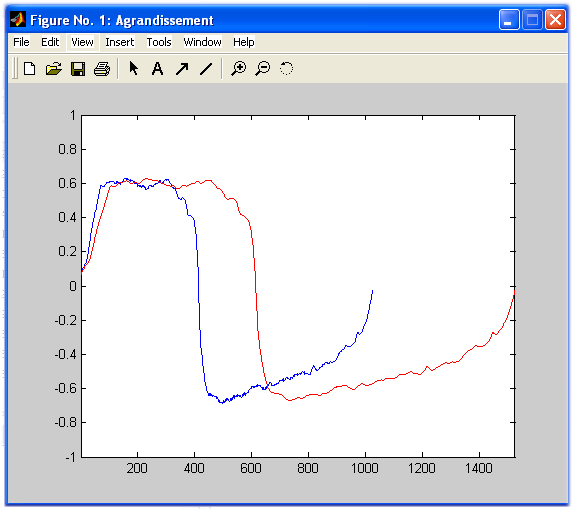Nb_zeros=200; % the original vector comprises 1024 samples, the interpolated vector 1024-200 = 824, ratio=0,80
Iter=200; % Iteration count
Sum_moy_red=zeros(1, size(Cyc_moy, 2)-Nb_zeros); % Initialisation of the vector sum
for i=1:Iter
Cyc_bom=bomb_alea(Cyc_moy, Nb_zeros);
Cyc_moy_red=[Cyc_moy(find(Cyc_bom)), zeros(1, size(Cyc_bom, 2)-Nb_zeros-size(Sum_moy_red, 2)) ]; % suppression of the 0
% and adjustment vector if necessary
Sum_moy_red=Sum_moy_red+Cyc_moy_red; % Sum reduced vector
end
Cyc_moy_red=Sum_moy_red/Iter; % Average
h=figure(1);
set(h,' name',' Origin and Interpolated Cycles',' resize',' off');
axis([1,1024,-1,1 ]);
hold one;
plot(Cyc_moy);
plot(Cyc_moy_red,' color',' r']);function x=bomb_alea(Cible, Nb_zeros)
% random bombardment of a target vector
% by Nb_zeros
if nargin==0;
Cible=[1:1:200];Nb_zeros=20; % values of test
end
fin=size(Cible, 2);
vec_01=ones(1, fin);
position=1;
Nb_points=1;
while Nb_points <= Nb_zeros
position=floor(Rand(1)*(fin-1)+1);
while vec_01(position)==0
position=floor(Rand(1)*(fin-1)+1);
end
vec_01(position)=0;
Nb_points=Nb_points+1;
end
x=Cible.*vec_01;
In the following program using a chaotic transformation of the vector, only the function bomb_alea changes. It is noticed there that one "cuts" the chaotic vector to the wished length, replacing the part removed by zeros which will be removed by the function find( ) of matlabfunction x=bomb_alea2(Cible, Nb_zeros)
if nargin==0; % Values of test
Cible=[1:1:200 ];
Nb_zeros=20;
end
fin=length(Cible);
pas_premier=primes(2000); % Primes values list
n=length(pas_premier);
choix=ceil(Rand(1)*n);
pas=pas_premier(choix); % One chooses a step with the hazard in the list of primes values
while rem(fin+1, pas)==0 % if the step is a divider of fin+1 one draws a new step
choix=ceil(Rand(1)*n); % does not occur if "fin" is even
pas=pas_premier(choix);
end
for i=1:fin
position(i)=modulo(i, not, fin+1); % Vector of addresses
Cible_crypt(position(i))=Cible(i); % Iindexed addressing
end
x_c=[Cible_crypt(1:fin-Nb_zeros), zeros(1, Nb_zeros) ]; % Section of the chaotic vector
x=x_c(position); % Rebuild the vector including Nb _ zeros randomly distributed

It is noticed that the signal is "less filtered" with a chaotic sampling, which is more regular than a random samplingWe can apply the same principle to enlarge the signal.
It is a question this time of adding samples (Nb_zeros) to the initial signal (Cible). Each sample is the average of the adjacent samples of the initial signal.
function Vect_augm=bomb_alea3(Cible,Nb_zeros)
% chaotic interpolation enlargment
if nargin==0; % default values
Cible=[1:1:200];
Nb_zeros=50;
end
fin=size(Cible,2)+Nb_zeros;
vec_01_org=zeros(1,size(Cible,2)+Nb_zeros);
vec_01_org(1:size(Cible,2))=1;
vec_01=zeros(1,size(Cible,2)+Nb_zeros);
Vect_augm=ones(1,fin);
pas_premier=primes(2000);
n=length(pas_premier);
choix=ceil(rand(1)*n);
pas=pas_premier(choix);% One chooses a step with the hazard in the list of primes values
while rem(fin+1,pas)==0 % if the step is a divider of fin+1 one draws a new step
choix=ceil(rand(1)*n);
pas=pas_premier(choix);
end
for i=1:fin
position(i)=modulo(i,pas,fin+1);
vec_01(position(i))=vec_01_org(i);
end vec_01(1)=1;
vec_01(fin)=1;
curseur=1;
for index=1:fin
if vec_01(index)~=0
Vect_augm(index)=Cible(curseur);
if curseur <= size(Cible,2)-1
curseur=curseur+1;
end
end
if vec_01(index)==0
Vect_augm(index)=(Cible(curseur-1)+Cible(curseur))/2;
end
end
% figure;
% plot(Vect_augm);Here the result:
Nb_zeros=500; % the vector of origin comprises 1024 samples, the vector interpolated 1024+500=1524, ratio=1.48
Iter=100; % Iteration count

The principle can of course apply to the processing of an image and thus constitute a pretreatment supplementing the orthogonalisation necessary to maximum storage on an associative memory. In the phase of image recognition , the structure in loop allows moreover the slip of the image by simply modifying the starting point from where the reading begins on the loop.
